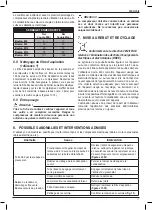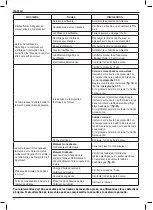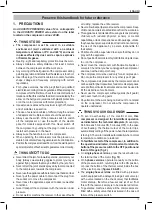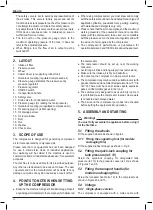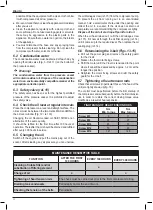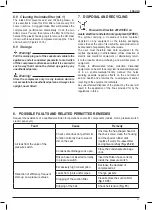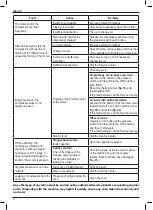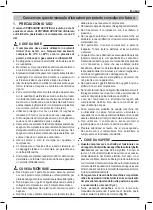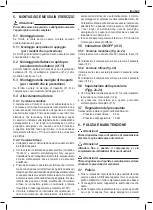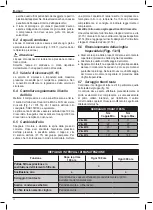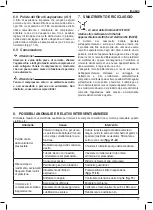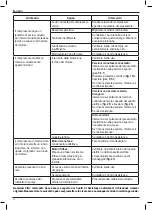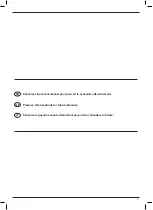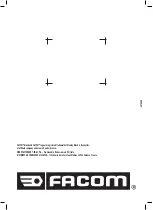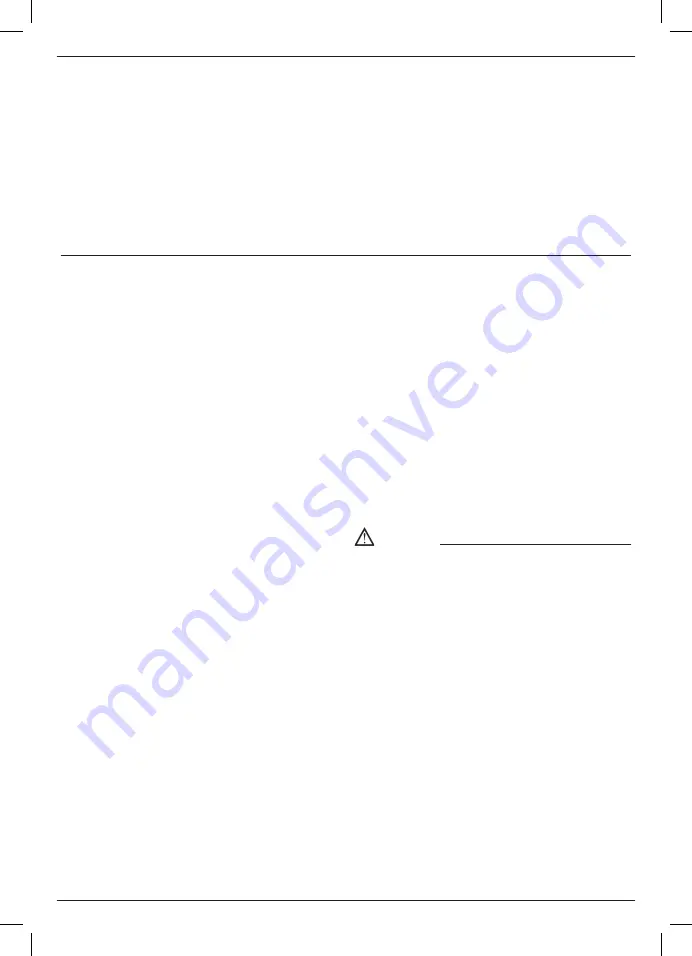
20
ENGLISH
The safety valve is set to avoid over-pressurization of
the air tanks. This valve is factory pre-set and will not
function unless tank pressure reaches this pressure. Do
not attempt to adjust or eliminate this safety device.
Any adjustments to this valve could cause serious injury.
If this device requires service or maintenance, see an
Authorized Service Center.
●
The red notch on the pressure gauge refers to the
maximum operating pressure of the tank. It does not
refer to the adjusted pressure.
● When fitting a tool, the flow of air in output must be
switched off.
●
When using compressed air, you must know and comply
with the safety precautions to be adopted for each type of
application (inflation, pneumatic tools, painting, washing
with water-based detergents only, etc.).
●
Please check that the air consumption and the maximum
working pressure of the pneumatic tool and connection
pipes (with the compressor) to be used, are compatible
with the pressure set on the pressure regulator and with
the amount of air supplied by the compressor.
● The compressor's performance is guaranteed for
operation between 0 and 1000 meters above the sea level.
2. LAYOUT
1. Intake air filter
2. Pressure vessel
3. Wheel
4. Caster wheel (or supporting rubber foot)
5. Quick-lock coupling (regulated compressed air)
6. Pressure gauge (indicates the pressure set by
pressure regulator)
7. Pressure regulator
8. ON/OFF switch
9. Transportation handle
10. Safety valve
11. Drain valve for condensation water
12. Pressure gauge (for reading the tank pressure)
13. Quick-lock coupling (unregulated compressed air)
14. Oil sealing plug (or oil filler opening)
15. Oil drainage screw
16. Oil level window
17. Bolt
18. Nut
19. Washer
20. Check valve
3. SCOPE OF USE
The compressor is designed for generating compressed
air for tools operated by compressed air.
Please note that our equipment has not been designed
for use in commercial, trade or industrial applications.
Our warranty will be voided if the machine is used in
commercial, trade or industrial businesses or for equivalent
purposes.
The machine is to be used only for its prescribed purpose.
Any other use is deemed to be a case of misuse. The user
/ operator and not the manufacturer will be liable for any
damage or injuries of any kind caused as a result of this.
4. POINTS TO NOTE WHEN SETTING
UP THE COMPRESSOR
●
Examine the machine for signs of transit damage. Report
any damage immediately to the company which delivered
the compressor.
●
The compressor should be set up near the working
consumer.
●
Avoid long air lines and long supply lines (extensions).
●
Make sure the intake air is dry and dust-free.
●
Do not set up the compressor in damp or wet rooms.
●
The compressor may only be used in suitable rooms (with
good ventilation and an ambient temperature from +5°C to
+40°C). There must be no dust, acids, vapors, explosive
gases or inflammable gases in the room.
●
The compressor is designed to be used in dry rooms. It
is prohibited to use the compressor in areas where work
is conducted with sprayed water.
●
The oil level in the compressor pump has to be checked
before putting the equipment into operation.
5. ASSEMBLY AND STARTING
Warning!
You must fully assemble the appliance before using it
for the first time.
5.1 Fitting the wheels
Fit the supplied wheels as shown in figure 4.
5.1.1 Fitting the supporting foot (for models
envisaging this)
Fit the supplied rubber stopper as shown in Fig. 6.
5.2 Fitting the quick-lock coupling for
tank pressure (ref. 13)
Screw the quick-lock coupling for unregulated tank
pressure (ref. 13) to the pressure vessel (ref. 2) as shown
in Figures 7 and 8.
5.3 Fitting the transport handle (for
models envisaging this)
Screw the transport handle (ref. 9) to the compressor as
shown in Figures 9 and 10.
5.4 Voltage
5.4.1 Single-phase version
The compressor is equipped with a mains cable with












